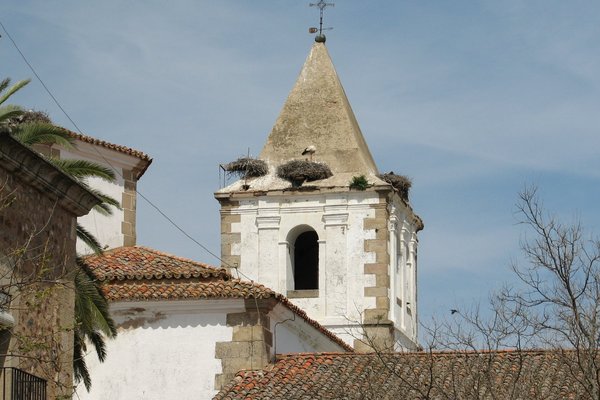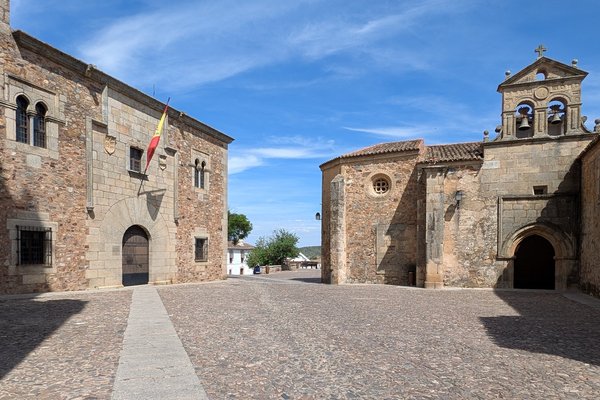Spain
Caceres
The Old Town of Cáceres is renowned for its well-preserved 12th-century Almohad city walls and its diverse townscape.
Cáceres was a historic battleground of the Moors and Christians, which resulted in Almohad fortifications such as the Torre Mochada and Torre del Bujaco. It was recaptured from the Moors in 1229. New groups of settlers were attracted, which led to rivalling factions constructing their houses, palaces and towers in their own styles. The city's architecture now is a blend of Roman, Islamic, Northern Gothic and Italian Renaissance styles.
Community Perspective: The Old Town is compact and a pleasure to navigate on foot. The Torre del Bujaco can be climbed and is worth it for its views.
Site Info
Official Information
- Full Name
- Old Town of Caceres (ID: 384)
- Country
- Spain
- Status
-
Inscribed 1986
Site history
History of Caceres
- 1986: Inscribed
- Inscribed
- Type
- Cultural
- Criteria
- iii
- iv
Links
- UNESCO
- whc.unesco.org
- Official
-
- turismocaceres.org — Turismo de Caceres
All Links
UNESCO.org
- whc.unesco.org — whc.unesco.org/
Official Website
- turismocaceres.org — Turismo de Caceres
News Article
- July 27, 2011 telegraph.co.uk — France is felling thousands of tress shading the banks of its Canal du Midi, due to a canker stain plague decimating plants along the 17th century marvel of engineering
Community Information
- Community Category
- Urban landscape: Urban continuity
Travel Information
Recent Connections
-
Perfect Inscriptions
1986 -
Gothic
Co-Cathedral among numerous other monum… -
Nunneries
Convento de San PabloSee es.wikipedia.o…
Connections of Caceres
- Individual People
-
-
Moctezuma Family
Palacio de los Toledo-Moctezuma, built by Juan Cano de Saavedra thanks to a large donation from his wife Isabel, daughter of the Aztec ruler Moctezuma II.
-
- History
-
-
Fusion
Crit iv: "bear the traces of highly diverse and contradictory influences, such as Northern Gothic, Islamic, Italian Renaissance and arts of the New World. " -
Almohads
"Caceres preserves one of the largest and well-preserved defensive enclosures from the Almohad period on the Iberian Peninsula from the 12th century. "
-
- Architecture
-
-
Gothic
Co-Cathedral among numerous other monumentsSee en.wikipedia.org
-
- World Heritage Process
-
-
Perfect Inscriptions
1986
-
- Religion and Belief
-
-
Cathedrals
St Mary's co-Cathedral -
Jewish religion and culture
Jewish quarter -
Nunneries
Convento de San PabloSee es.wikipedia.org
-
- Constructions
-
-
Walled cities
-
Cisterns
"the five-nave reservoir with three bays, incorporated into the Casa de las Veletas in the 16th century" -
Hospitals
Hospital de los Caballeros
-
- Timeline
-
-
Built in the 12th century
seized by the Arabs and made into a fortified city
-
- WHS Hotspots
News
- telegraph.co.uk 07/27/2011
- France is felling thousands of tre…
Recent Visitors
Visitors of Caceres
- Adam Hancock
- Adolfo
- Adrian Turtschi
- Alberto Rodriguez Gutierrez
- Alexander Barabanov
- Alexander Lehmann
- Alikander99
- Ali Zingstra
- Ammon Watkins
- Ana
- Ana Lozano
- Anna Wludarska
- Antonio J.
- Argo
- Atila Ege
- BaziFettehenne
- Bill Maurmann
- Bin
- Bruno_Pires
- Caspar
- Catoplayer
- chenboada
- Cheryl
- Christian Wagner
- Christravelblog
- Claire Bradshaw
- Clyde
- Corinne Vail
- Csaba Nováczky
- CugelVance
- Daniela Hohmann
- Dan Pettigrew
- David Berlanda
- debatecoach
- Dennis Nicklaus
- Dimitar Krastev
- Dimitrios Polychronopoulos
- Don Irwin
- Dorejd
- Elis
- Els Slots
- Emilia
- Emili Xaus
- Errol Neo
- Eva Kisgyorgy
- Evgenii
- Fan Yibo
- Farinelli
- Femke Roos
- Filip Murlak
- Frederik Dawson
- Gary Arndt
- George Gdanski
- GeorgeIng61
- Hadrianus
- HaraldOest
- Harald T.
- Harry Mitsidis
- henrik_hannfors
- Hubert
- Iain Jackson
- Ivan Rucek
- Jakob F.
- Janina Lehmann
- Janos
- Jarek Pokrzywnicki
- Jasam
- Javier
- Javier Coro
- Jean Lecaillon
- Jeanne OGrady
- Jens
- Jezza
- JobStopar
- Joel on the Road
- Jonas Hagung
- Jonas Kremer
- KarenBMoore
- kayakka
- Ken DJ
- KentishTownRocks
- Klaus Freisinger
- krtek
- Kurt Lauer
- Lara Adler
- lichia
- Lisu Marian
- Little Lauren Travels
- ljowers
- Loic Pedras
- Luboang
- Luis Filipe Gaspar
- Maciej Gil
- Martin
- Martinacurra88
- Martina Rúčková
- MaYumin
- MH
- M. Huineman
- Michael Novins
- michaelsballard
- Mikan22
- Mikko
- MMM
- nan
- napalm
- Nihal Ege
- PabloNorte
- Palimpsesto
- Patrik
- Paul Schofield
- Persian Globetrotter
- Philipp Leu
- Philipp Peterer
- phillipmeng
- Pink Bunny
- Piotr Wasil
- Porcho
- Randi Thomsen
- Reza
- Rick Ohm
- RobRos
- Roger Ourset
- Roman Bruehwiler
- Samy G
- Schnitzel
- Sclowitz
- scubarrie
- Sergio Arjona
- Shandos Cleaver
- sibariam
- Solivagant
- Stan
- Stanislaw Warwas
- Svein Elias
- Szucs Tamas
- Tamara Ratz
- Taotao Chen
- Tarquinio_Superbo
- Tevity
- Thomas Buechler
- Thomas van der Walt
- Tim Allen
- tony0001
- triath
- Truls Brekke
- ValiaVeweth
- Vanessa Buechler
- Viaje al Patrimonio
- voyager
- Walter
- Wieland
- Wojciech Fedoruk
- Xander Huang
- Xiong Wei
- Xiquinho Silva
- Zoë Sheng
Community Reviews
Show full reviews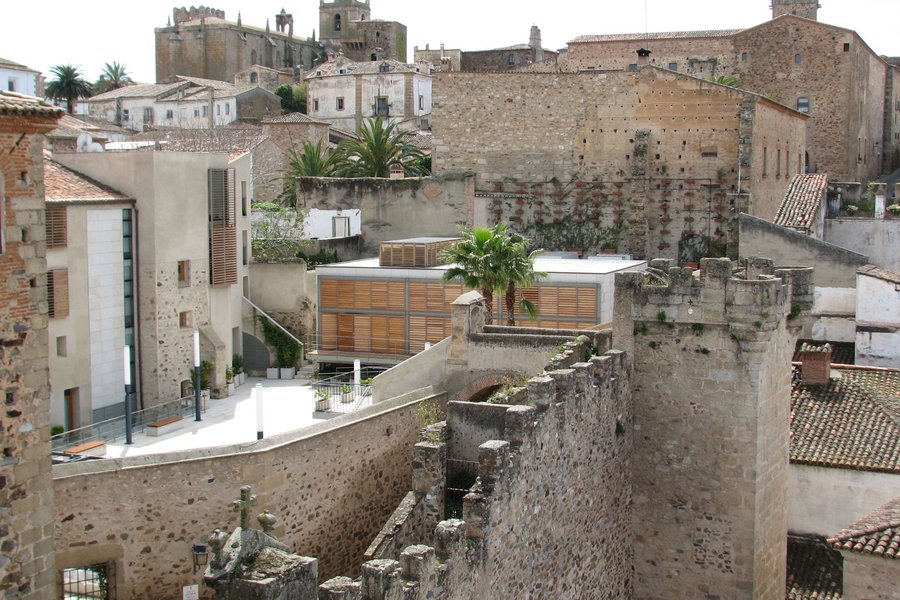
Today I traveled by car to visit this site. Many others have described the fact that it's surrounded by structures that you actually don't see inscribed area from a distance. They also did an accurate evaluation of the site which I used to orient myself. I took the advice and put Plaza Mayor and then added parking in my GPS and found the parking lot Obispo Galarza ( 2 Euro for 3 hours). As you exit the garage, Head to the right. There is a walkway with an escalator on your left. Head down that way and bear right at the bottom. The will be a sign for Historic Center in Spanish taking you off to the left. At the end you are at Plaza Mayor. Across the Plaza looking to the left you will see the Tourist Center. They will give you a nice map and I told them I was here for the UNESCO sites and the lady gave me a brochure that is a publicity piece but has more of the history. Enjoy.
Keep reading 0 comments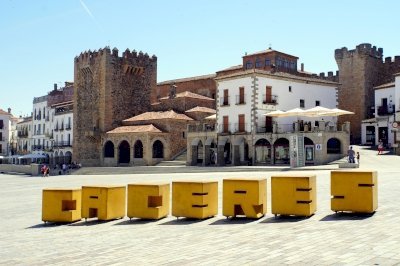
The Old Town of Cáceres is also called Ciudad Monumental - the Monumental City. A little exaggerated from today's perspective, as the historic centre is well hidden in the middle of the modern city. You only realise that you have reached your destination when you stand in front of the old city wall at the Plaza Mayor (photo). This was certainly different in the Middle Ages, when the city wall and the massive towers were visible from afar.
The Plaza Mayor is the bustling centre of modern Cáceres with plenty of shops and bars. But the atmosphere changes as soon as you walk through the Arco de la Estrella and enter the core zone of the WHS, the intramuros town. The old town has been preserved almost unchanged as it was in the 16th century, there are almost no signs of modernization. It is like a journey back in time to the Middle Ages. One inevitably wonders how many people still live there today. And when I walked along the massive walls of the Renaissance palaces and looked up at the huge towers, I understood why it is called monumental.I visited the Cathedral Santa Maria, I climbed the Torre del Bujaco where you can walk a short section of the city wall, and I visited the cistern in the Palacio de las Veletas (today the city museum). However, none of this is a real highlight. The highlight of Cáceres is roaming the narrow, cobbled streets. I enjoyed exploring the …
Keep reading 0 comments
Cáceres is one of many WH-listed towns on the Iberian peninsula, and because of its somewhat remote location, it's one of the less visited ones. I enjoyed my stay there, and it's really very pleasant to walk through the narrow alleys and admire the many historic buildings, or to sit down on the Plaza Mayor (just outside the Old Town) and do some tapa-eating and people-watching (a bit similar to Salamanca, just much smaller). There are, however, no outstanding individual attractions, so the charm of Cáceres is more in its almost unchanged medieval ensemble rather than in any one building. If an individual building should be mentioned, then it is probably the Torre del Bujaco, a 12th-century watchtower worth climbing for its views of the Old Town on one side and the Plaza Mayor on the other. Also, Cáceres is a good base from which to explore the many sights of Extremadura (especially Mérida, Trujillo and the Guadalupe Monastery), which is still relatively unknown to non-Spaniards.
Keep reading 0 comments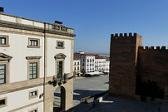
I visited this WHS in August 2014. I spent 1 night here in a hotel overlooking the central Plaza Mayor. The different styles of architecture are immediately visible from there (picture). Unfortunately in August there were no storks to be seen although I could see their nests everywhere but I was extra lucky to spot a domestic peacock walking freely on one of the tower walls! The historic centre is full of towers some of which are open to the public. The episcopal palace and church are worth visiting as well as the Puerta Merida and Jewish Quarter. The highlight of my visit was wandering about the narrow roads and alleys early in the morning, where I was lucky enough to see some "peregrinos" on there way to Santiago de Compostela and where I met a 94 year old priest who kindly gave me a detailed overview of the history of Caceres over time. I won't count my visit to Caceres and other sites I visited around Spain (such as nearby Burgos, San Millan de la Cogolla, Salamanca, etc.) as a valid visit to the Route of Santiago de Compostela in Spain as I intend to do the real thing next year when I embark on the Camino from France to Santiago.
Keep reading 0 comments
From opposite Caceres station I took bus # L1 to the Plaza Major and entered the compact old town through the Arch of the Stars. While this entrance and the old walls and towers are in a good state of repair the buildings are really nothing special compared to Salamanca or Segovia.
Fiestas must be a regular feature here because one was in progress in the Plaza Las Valetas during my visit.
Keep reading 0 comments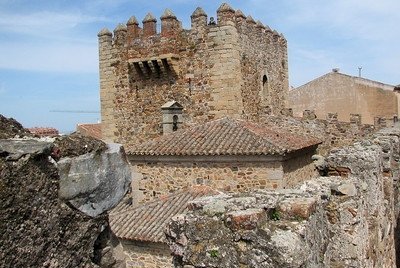
Modern Caceres is a sprawling and bustling city with about 90.000 inhabitants. You cannot even see the towers of the Old Town from the access roads, as it's all very built up. No trouble parking though, for a mere 1 Euro-cent per minute I had a spot in a parking garage very close to the center.
A few narrow streets and you're at the Plaza Mayor, where you'll get the first view of the magnificent gates, walls, and towers of Caceres. The Torre del Bujaco is the most prominent one. You can climb it, and get a good overview of the historic centre. And have a good look at the numerous storks. They clearly like all those towers for nesting!
The Old Town is very compact and a pleasure to navigate on foot. It holds historic buildings very similar in style and colouring. It has a museum-ish atmosphere because only at the fringes there are houses where people actually live in. At one of the little plazas, a folk music & dance group was performing, entertaining the numerous day trippers around. I ended my tour on a terrace in the sun, an appropriate ending to a pleasant afternoon spent in Old Caceres.
Keep reading 0 comments
